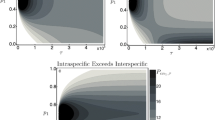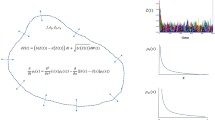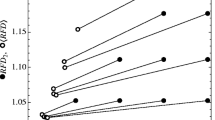Abstract
Neutral community theory explains biodiversity, i.e. the coexistence of several species, as the result of a stochastic balance between immigration and extinction on a local level, and between speciation and extinction on a regional level. The most popular model, presented by Hubbell in 2001, has seen many analytical developments in recent years, which can be used in model analysis, model testing and model comparison. We review these developments here, and present alternative derivations and shine previously unnoticed lights on them.
Similar content being viewed by others
References
P. A. Abrams, The theory of limiting similarity. Ann. Rev. Ecol. Syst. 14:359–376 (1983).
D. Alonso, The Stochastic Nature of Ecological Interactions. Communities, Metapopulations, and Epidemics. Polytechnical University of Catalonia, Spain. PhD. thesis (2004).
D. Alonso and A. J. McKane, Sampling Hubbell’s neutral theory of biodiversity. Ecol. Lett. 7:901–910 (2004).
D. Alonso, R. S. Etienne and A. J. McKane, The merits of neutral theory. Trends in Ecol. Evol. 21:451–457 (2006).
J. R. Banavar, J. L. Green, J. Harte and A. Maritan, Finite size scaling in ecology. Phys. Rev. Lett. 83:4212 (1999).
J. Bascompte and R. V. Solé, eds., Modeling Spatiotemporal Dynamics in Ecology, Berlin, Germany: Springer and Landes Bioscience (1997).
G. Bell, Neutral macroecology. Science 293:2413–2418 (2001).
G. Boros and V. Moll, Irresistible Integrals: Symbolics, Analysis and Experiments in the Evaluation of Integrals. Cambridge, U. K.: Cambridge University Press (2004).
M. Bramson, J. T. Cox and R. Durrett, A spatial model for the abundance of species. Ann. Probability 26:658–709 (1997).
H. Caswell, Community structure: A neutral model analysis. Ecol. Monogr. 46:327–354 (1976).
J. Chave, Neutral theory and community ecology. Ecol. Lett. 7:241–253 (2004).
J. Chave and E. G. Leigh, A spatially explicit neutral model of β -diversity in tropical forests. Theor. Popul. Biol. 62:153–168 (2002).
J. Chave, D. Alonso and R. S. Etienne, Comparing models of species abundance. Nature 441:E1 (2006).
P. L. Chesson, Mechanisms of maintenance of species diversity. Annu. Rev. Ecol. Systematics 31:343–366 (2000).
P. L. Chesson and R. R. Warner, Environmental variability promotes coexistence in lottery competitive systems. Am. Nat. 125:923–943 (1981).
F. E. Clements, Plant Succession: An Analysis of the Development of Vegetation. Washington, DC: Carnegie Institute of Washington Publication, p. 242, (1916).
J. E. Cohen and C. M. Newman, A stochastic theory of community food webs: I. Models and aggregated data. Proc. R. Soc. Lond. B 224:421–448 (1985).
R. Condit, N. Pitman, E. G. Leigh, J. Chave, J. Terborgh, R. B. Foster, P. Nuñez, S. Aguilar, R. Valencia, G. Villa, H. C. Muller-Landau, E. Losos and S. P. Hubbell, Beta-diversity in tropical forest trees. Science 295:666–669 (2002).
D. Costantini and U. Garibaldi, The Ehrenfest fleas: from model to theory. Synthese 139:107–142 (2004).
A. K. Dewdney, A general theory of the sampling process with applications to the “veil line.” Theor. Popul. Biol. 54:294–302 (1998).
A. K. Dewdney, A dynamical model of communities and a new species-abundance distribution. Biol. Bull. 35:152–165 (2000).
O. H. Diserud and S. Engen, A general and dynamic species abundance model, embracing the lognormal and the gamma models. Am. Nat. 155:497–511 (2000).
M. Dornelas, S. R. Connolly and T. P. Hughes, Coral reef diversity refutes the neutral theory of biodiversity. Nature 440:80–82 (2006).
R. Durrett, Stochastic spatial models. SIAM Rev. 41:677–718 (1999).
R. Durrett and S. Levin, Spatial models for species-area curves. J. Theor. Biol. 179:119–127 (1996).
C. Elton, Animal Ecology. London, U. K.: Sidgewick & Jackson (1927).
S. Engen and R. Lande, Population dynamic models generating the lognormal species abundance distribution. Math. Biosci. 132:169–183 (1996a).
S. Engen and R. Lande, Population dynamic models generating the species abundance distributions of the Gamma type. J. Theor. Biol. 178:325–331 (1996b).
R. S. Etienne, A new sampling formula for neutral biodiversity. Ecol. Lett. 8:253–260 (2005).
R. S. Etienne and D. Alonso, A dispersal-limited sampling theory for species and alleles. Ecol. Lett. 8:1147–1156 (2005). Erratum in Ecol. Lett. 9:500.
R. S. Etienne and H. Olff, How dispersal limitation shapes species—body size distributions in local communities. Am. Nat. 163:69–83 (2004a).
R. S. Etienne and H. Olff, A novel genealogical approach to neutral biodiversity theory. Ecol. Lett. 7:170–175 (2004b).
R. S. Etienne and H. Olff, Confronting different models of community structure to species-abundance data: a Bayesian model comparison. Ecol. Lett. 8:493–504 (2005).
R. S. Etienne, A. M. Latimer, J. A. Silander and R. M. Cowling, Comment on “Neutral ecological theory reveals isolation and rapid speciation in a biodiversity hot spot.” Science 311:610b (2006).
W. J. Ewens, The sampling theory of selectively neutral alleles. Theor. Popul. Biol. 3:87–112 (1972).
T. Fagerström, Lotteries in communities of sessile organisms. Trends in Ecol. Evol. 3:303–306 (1988).
R. A. Fisher, The Genetical Theory of Natural Selection. Oxford, U. K.: Clarendon Press (1930).
R. A. Fisher, A. S. Corbet and C. B. Williams, The relation between the number of species and the number of individuals in a random sample of an animal population. J. Anim. Ecol. 12:42–58 (1943).
G. F. Gause, The Struggle for Existence. Baltimore, MD: Williams and Wilkins (1934).
H. A. Gleason, The individualistic concept of the plant association. Bull. Torrey Botanical Club 53:7–26 (1926).
H. A. Gleason, The individualistic concept of the plant association. Am. Midland Nat. 21:92–110 (1939).
N. J. Gotelli, Null model analysis of species co-occurrence patterns. Ecology 81:2606–2621 (2000).
D. Gravel, C. D. Canham, M. Beaudet and C. Messier, Reconciling niche and neutrality: the continuum hypothesis. Ecol. Lett. 9:399–409 (2006).
R. C. Griffiths and S. Lessard, Ewens’ sampling formula and related formulae: Combinatorial proofs, extensions to variable population size and applications to ages of alleles. Theor. Popul. Biol. 68:167–177 (2005).
J. Grinnell, The niche-relationships of the California Thrasher. Auk 34:427–433 (1917).
J. Grinnell, On the role of the accidental. Auk 39:373–380 (1922).
J. Harte, Tail of death and resurrection. Nature 424:1006–1007 (2003).
F. L. He, Deriving a neutral model of species abundance from fundamental mechanisms of population dynamics. Funct. Ecol. 19:187–193 (2005).
F. He and S. P. Hubbell, Percolation theory for the distribution and abundance of species. Phys. Rev. Lett. 91:198103 (2003).
B. Houchmandzadeh and M. Vallade, Clustering in neutral ecology. Phys. Rev. E 68:061912 (2003).
X.-S. Hu and F. He, Neutral theory in macroecology and population genetics. Oikos in press (2006).
X.-S. Hu, F. He and S. P. Hubbell, Neutral theory in macroecology and population genetics. Oikos 113: 548–556 (2006).
S. P. Hubbell, The Unified Neutral Theory of Biodiversity and Biogeography. Princeton, NJ: Princeton University Press (2001).
G. E. Hutchinson, Concluding remarks. Cold Spring Harbor Symp. Quant. Biol. 22:415–427 (1957).
G. E. Hutchinson, The paradox of the plankton. Am. Nat. 95:137–145 (1961).
N. L. Johnson, S. Kotz and N. Balakrishnan, Discrete Multivariate Distributions. New York, NY: Wiley (1997).
S. Karlin and J. McGregor, Addendum to a paper of W. Ewens. Theor. Popul. Biol. 3:113–116 (1972).
M. Kimura, The Neutral Theory of Molecular Evolution. Cambridge, U. K.: Cambridge University Press (1983).
J. M. Kneitel and J. M. Chase, Trade-offs in community ecology: linking spatial scales and species coexistence. Ecol. Lett. 7:69–80 (2004).
R. Lande, S. Engen and B.-E. Saether, Stochastic Population Dynamics in Ecology and Conservation. Oxford Series in Ecology and Evolution. Oxford, U. K.: Oxford University Press (2003).
S. A. Levin, Complex adaptive systems: exploring the known, the unknown, and the unknowable. Bull. Am. Math. Soc. 40:3–19 (2003).
R. H. MacArthur, On the relative abundance of bird species. Proc. Natl. Acad. Sci., USA 43:293–295 (1957).
R. H. MacArthur, On the relative abundance of species. Am. Nat. 94:25–36 (1960).
R. H. MacArthur and E. O. Wilson, Island Biogeography. Princeton, NJ: Princeton University Press (1967).
R. Margalef, Through the looking glass: how marine phytoplankton appears through the microscope when graded by size and taxonomically sorted. Scientia Marina 58:87–101 (1994).
P. A. Marquet, J. E. Keymer and H. Cofré, Breaking the stick in space: of niche models, metacommunities and patters of relative abundance of species. in T. M. Blackburn & K. J. Gaston, eds. Macroecology. Concepts and consequences. Oxford, U. K.: Blackwell, pp. 64–84 (2003).
B. J. McGill, A test of the unified neutral theory of biodiversity. Nature 422:881–885 (2003a).
B. J. McGill, Strong and weak tests of macroecological theory. Oikos 102:679–685 (2003b).
A. J. McKane, D. Alonso and R. V. Solé, A mean field stochastic theory for species rich assembled communities. Phys. Rev. E 62:8466–8484 (2000).
A. J. McKane, D. Alonso and R. V. Solé, Analytic solution of Hubbell’s model of local community dynamics. Theor. Popul. Biol. 65:67–73 (2004).
L. R. Moore, G. Rocap and S. W. Chisholm, Physiology and molecular phylogeny of coexisting prochlorococcus ecotypes. Nature 393:464–467 (1998).
P. A. P. Moran, Random processes in genetics. Proc. Cambridge Philos. Soc. 54:60–71 (1958).
P. A. P. Moran, Statistical Processes of Evolutionary Theory. Oxford, U. K.: Clarendon Press (1962).
N. Mouquet and M. Loreau, Coexistence in metacommunities: the regional similarity hypothesis. Am. Nat. 159:420–426 (2002).
S. Nee, The neutral theory of biodiversity: do the numbers add up? Funct. Ecol. 19:173–176 (2005).
F. W. Preston, The commonness and rarity of species. Ecology 29:254–283 (1948).
S. Pueyo, Diversity: between neutrality and structure. Oikos 112:392–405 (2006).
G. Sella and A. E. Hirsh, The application of statistical physics to evolutionary biology. Proc. Natl. Acad. Sci., USA 102:9541–9546 (2005).
G. Sugihara, Minimal community structure: an explanation of species-abundance patterns. Am. Nat. 116:770–787 (1980).
R. Johnson and C. Townsend, A truce with neutral theory: local deterministic factors, species traits and dispersal limitation together determine patterns of diversity in stream invertebrates. J. Anim. Ecol. 75:476–484 (2006).
D. Tilman and S. Pacala, The maintenance of species richness in plant communities. in: Species Diversity in Ecological Communities; Historical and Geographic Perspectives, R. E. Ricklefs and D. Schluter, eds. Chicago, IL: University of Chicago Press, pp. 13–25 (1993).
R. Thompson and C. Townsend, A truce with neutral theory: local deterministic factors, species traits and dispersal limitation together determine patterns of diversity in stream invertebrates. J. Anim. Ecol. 75:476–484 (2006).
D. Tilman, Diversity by default. Science 283:495–496 (1999).
C. S. Ting, G. Rocap, J. King and S. W. Chisholm, Cyanobacterial photosynthesis in the oceans: the origins and significance of divergent light-harvesting strategies. Trends in Microbiol. 10:134–142 (2002).
M. Tokeshi, Niche apportionment or random assortment—species abundance patterns revisited. J. Anim. Ecol. 59:1129–1146 (1990).
M. Tokeshi, Species abundance patterns and community structure. Adv. Ecol. Res. 24:111–186 (1993).
M. Tokeshi, Power fraction: a new explanation of relative abundance patterns in species-rich assemblages. Oikos 75:543–550 (1996).
M. Vallade and B. Houchmandzadeh, Analytical solution of a neutral model of biodiversity. Phys. Rev. E 68:061902 (2003).
T. Vicsek, Fluctuations and Scaling in Biology. Oxford, U. K.: Oxford University Press (2001).
I. Volkov, J. R. Banavar, S. P. Hubbell and A. Maritan, Neutral theory and relative species abundance in ecology. Nature 424:1035–1037 (2003).
I. Volkov, J. R. Banavar, S. P. Hubbell and A. Maritan, Organization of ecosystems in the vicinity of a novel phase transition. Phys. Rev. Lett. 92:218703 (2004).
I. Volkov, J. R. Banavar, F. He, S. P. Hubbell and A. Maritan, Density dependence explains tree species abundance and diversity in tropical forests. Nature 438:658–661 (2005).
J. Wakeley, Coalescent Theory. An Introduction. Greenwood Village, CO: Roberts & Co (2004).
G. A. Watterson, Models for the logarithmic species abundance distribution. Theor. Popul. Biol. 6:217–250 (1974).
R. H. Whittaker, A consideration of climax theory: the climax as a population and pattern. Ecol. Monogr. 23:41–78 (1953).
R. J. Williams and N. D. Martinez, Simple rules yield complex food webs. Nature 404:180–183 (2000).
S. Wright, Evolution in Mendelian populations. Genetics 16:97–159 (1931).
D. W. Yu, J. W. Terborgh and M. D. Potts, Can high tree species richness be explained by Hubbell’s null model? Ecol. Lett. 1:193–199 (1998).
T. Zillio, I. Volkov, J. R. Banavar, S. P. Hubbell and A. Maritan, Spatial scaling in model plant communities. Phys. Rev. Lett. 95:098101 (2005).
Author information
Authors and Affiliations
Corresponding author
Rights and permissions
About this article
Cite this article
Etienne, R.S., Alonso, D. Neutral Community Theory: How Stochasticity and Dispersal-Limitation Can Explain Species Coexistence. J Stat Phys 128, 485–510 (2007). https://doi.org/10.1007/s10955-006-9163-2
Received:
Accepted:
Published:
Issue Date:
DOI: https://doi.org/10.1007/s10955-006-9163-2




